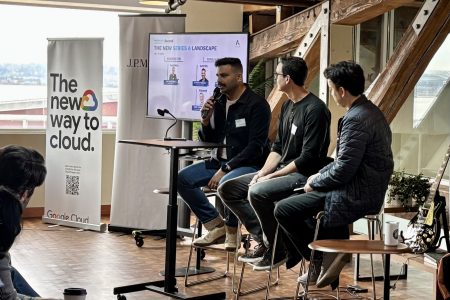Todd Humphrey: Enhancing Customer Experiences Through Technology and Human Connection
In the heart of Seattle, Todd Humphrey observes coffee shop patrons with the analytical eye of someone who has spent his career understanding customer behavior. Within minutes, he’s evaluating how people interact with each other and their devices, a reflection of his decades of experience in enhancing customer experiences through technology. This approach has defined Humphrey’s diverse career path—from his early work at Kobo developing e-reader services to co-founding healthcare startup League, leading project management company LiquidPlanner, and most recently serving as senior vice president of innovation and fan experience for the Seattle Kraken NHL franchise. His professional journey represents a continuous exploration of how technology can improve human experiences while maintaining essential personal connections.
After departing from the Kraken earlier this year, Humphrey launched Highmark Sports Group, a consultancy aimed at helping sports organizations optimize their operations and enhance fan experiences. Despite this new direction, the Canadian native and former professional hockey player maintains strong ties to Seattle’s hockey community, serving as a senior advisor for the Seattle Torrent, the city’s new women’s professional hockey team. He’s also lending his expertise to the Hockey Hall of Fame in Toronto, bringing his unique perspective on fan engagement to these iconic institutions. Humphrey’s approach combines his deep understanding of sports culture with his technological expertise, creating experiences that resonate with modern audiences while honoring traditions that make sports meaningful.
Humphrey’s vision for customer experience in 2025 reflects a dramatic evolution from the past. “I’m old enough to remember what the experience used to be like,” he recalls, describing the simplicity of reading about games in newspapers and arriving at venues filled with the aroma of stale beer and popcorn. Today’s experience, by contrast, is comprehensively reimagined through technology. Humphrey approaches the fan experience as a door-to-door journey with numerous touchpoints—from checking an app in the morning to navigating transportation, entering the venue, and minimizing wait times. During his tenure with the Kraken, he focused on reducing the traditional one-hour wait time NHL fans typically experience during a three-hour event. His strategy employed digital ticketing, intuitive wayfinding systems, mobile ordering, and payment solutions to create frictionless experiences. “We really used that Amazon approach of the customer experience and working backward,” Humphrey explains. “What are all the friction points, and how do we alleviate those?” This methodology extends beyond sports to concerts, museums, and other public spaces, transforming how organizations conceptualize visitor experiences beyond the time spent within their physical walls.
The delicate balance between technological advancement and authentic human connection stands at the core of Humphrey’s philosophy. While he acknowledges technology as an essential “vessel” in modern customer experiences—”everybody’s got a computer in their pocket”—he cautions against overemphasizing technology at the expense of human interaction. For Humphrey, seemingly small personal touches often make the most significant impact. The initial interactions with ticketing staff and security personnel can set the tone for an entire event, making proper training in customer engagement crucial. “Training people who work there to greet people, engage with people, look them in the eye, and get to know who they are—it’s a huge advantage,” he emphasizes. Humphrey applies this perspective to his own experiences as well, noting his preference for human cashiers over self-checkout at grocery stores. “They’ve seen my kids grow up over the years. They know who I am and what I do,” he shares, highlighting the value of these established connections. While acknowledging AI’s role in providing greater efficiency, Humphrey believes the technological shift actually increases the importance of live gatherings. “People just have an innate desire to be together and cheer together,” he observes, suggesting that shared experiences fulfill fundamental human needs that technology alone cannot satisfy.
When advising startup leaders on improving customer experiences, Humphrey recommends working backward from the ideal customer journey. “More companies need to take their customer experience and work backwards,” he suggests, emphasizing the importance of conviction in product development alongside extensive customer communication. He cautions against building products in isolation, advocating instead for regular customer feedback to guide strategic direction. However, Humphrey stresses that leadership teams must ultimately “pick their lane” and develop strong convictions about their approach. The comprehensive understanding of the customer journey—whether for SaaS clients, cloud services users, or AI-driven applications—should inform business development at every stage. “What is that customer going to feel all the way through the experience?” Humphrey asks, framing the central challenge for business leaders. “Can you build a business that delivers an incredible, top-tier experience—and also drives revenue? It’s a hard thing to do.”
Humphrey’s career journey and philosophy represent a thoughtful approach to integrating technology into human experiences without losing sight of what makes these experiences meaningful. From sports arenas to retail environments, his work demonstrates that successful customer experiences balance innovation with personal connection. As technology continues advancing—with AI and automation increasingly prevalent—Humphrey’s perspective serves as a reminder that the most memorable experiences often result from genuine human interactions enhanced, rather than replaced, by technological tools. His work with the Kraken, Seattle Torrent, and now through Highmark Sports Group illustrates how organizations can employ cutting-edge solutions while preserving the emotional connections that draw people together. In an increasingly digital world, Humphrey’s approach suggests that the most successful customer experiences will continue to be those that recognize technology as a means to an end: creating more meaningful, efficient, and joyful human connections.














